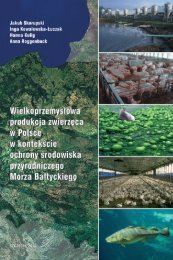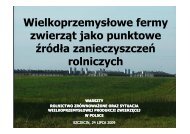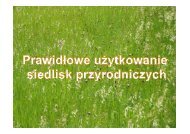best available technologies for manure treatment - Baltic Green Belt
best available technologies for manure treatment - Baltic Green Belt
best available technologies for manure treatment - Baltic Green Belt
Create successful ePaper yourself
Turn your PDF publications into a flip-book with our unique Google optimized e-Paper software.
Best Available Technologies <strong>for</strong> <strong>manure</strong> <strong>treatment</strong> baltic sea 2020<br />
ANNEX I: REPORT FROM ROUNDTABLE DISCUSSION<br />
Agenda<br />
1. Welcome, Conrad Stralka, <strong>Baltic</strong> Sea 2020<br />
2. Introduction and programme, moderated by<br />
Project Leader Henning Lyngsø Foged<br />
3. Presentation of participants<br />
4. Presentation of the project, Lotta Samuelson,<br />
<strong>Baltic</strong> Sea 2020, and Henning Lyngsø Foged,<br />
CBMI<br />
5. Expert statement about leaching of N and P from<br />
pig <strong>manure</strong>s, Fredrik Wulff, <strong>Baltic</strong> Sea 2020<br />
6. Presentation of complete list of <strong>technologies</strong><br />
which are identified within the project, their<br />
advantages and disadvantages, Henning Lyngsø<br />
Foged, CBMI<br />
7. Discussion about prioritising the <strong>manure</strong> <strong>treatment</strong><br />
<strong>technologies</strong> against the parameters defined<br />
in the project, moderated by Henning Lyngsø<br />
Foged, CBMI<br />
8. Results of survey and discussion about IPPC<br />
Communication and Implementation, Henning<br />
Lyngsø Foged, CBMI<br />
9. Summing up and concluding, Lotta Samuelson,<br />
<strong>Baltic</strong> Sea 2020<br />
Discussed<br />
Re. 1: Welcome<br />
Conrad Stralka in<strong>for</strong>med in his welcome about the<br />
activities of <strong>Baltic</strong> Sea 2020.<br />
Re. 2: Introduction<br />
Henning Foged emphasized in his introduction how<br />
important we consider the stakeholders in relation to<br />
the ultimate success criteria <strong>for</strong> the project – a higher<br />
degree of livestock <strong>manure</strong> <strong>treatment</strong> to reduce the<br />
leaching of N and P. Henning Foged also said that<br />
the project should be seen as supporting and linking<br />
up to other initiatives concerning livestock <strong>manure</strong><br />
<strong>treatment</strong> <strong>technologies</strong>.<br />
Re. 3: Presentation of participants<br />
The meeting had 11 participants from 5 of the 8<br />
target countries.<br />
Re. 4: Presentation of the project<br />
Lotta Samuelson mentioned especially that the overall<br />
objective of the “Best Practice Manure Projects”<br />
is to reduce leaching of nutrients from large installations<br />
<strong>for</strong> the intensive rearing of pigs around the<br />
<strong>Baltic</strong> Sea. Phase 1 of the project concluded that according<br />
to statistics from EU Joint Research Bureau,<br />
nutrients in <strong>manure</strong> put on fields in the <strong>Baltic</strong> Sea<br />
catchment area exceeds the nutrient discharge from<br />
households in the same area. <strong>Baltic</strong> Sea 2020 will<br />
focus on reducing nutrient leaching in <strong>manure</strong> from<br />
installations <strong>for</strong> the intensive rearing of pigs to the<br />
aquatic environment.<br />
Henning Foged pointed out that the IPPC<br />
Directive is 13 years old, it came into <strong>for</strong>ce in a<br />
period where livestock <strong>manure</strong> <strong>treatment</strong> was rarely<br />
happening, and since then has a major structural<br />
development had taken place in the pig production<br />
sector. Danish installations <strong>for</strong> the intensive rearing<br />
of pigs had an average of 550 pigs per farm with pigs<br />
in 1996, including both sows, piglets and fatteners<br />
– today this figure is 2.250! It seems justified that<br />
the project on this background considers, whether<br />
livestock <strong>manure</strong> <strong>treatment</strong> <strong>technologies</strong> should be<br />
given more focus in the administration of the IPPC<br />
Directive.<br />
Vaclovas Beržinskas said during the discussion,<br />
water monitoring should be part of the project and<br />
that part of the problem with leaching is a setback<br />
that the environmental permitting institutions do not<br />
wish to deal with complicated issues.<br />
Re. 5: Expert statement<br />
Fredrik Wulff focused in his presentation on the<br />
input of N and P to the <strong>Baltic</strong> Sea from agricultural<br />
production in the <strong>for</strong>m of fertilisers and feed. The<br />
agriculture sector is calculated to provide <strong>for</strong> 50%<br />
of the total nutrient load to the <strong>Baltic</strong> Sea. The EU<br />
legislation as well as voluntary actions by farmers has<br />
resulted in more efficient use of fertilisers and excess<br />
nutrients to the waterways leaching is expected to decrease<br />
n the coming years. Denmark has had a large<br />
decline in its use of mineral fertiliser, but simultaneously<br />
a large increase in imported protein feed.<br />
Professor Wulff cited a Finnish study, which had<br />
shown that 11% of N and 17% of P had leached<br />
from <strong>manure</strong>s spread in the autumn, while the leaching<br />
was 33% of N and 59% of P in <strong>manure</strong>s spread<br />
in the winter.<br />
91








